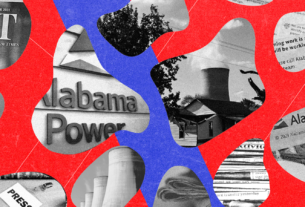RICHMOND, Calif. — Open flames shot upward from four smokestacks at the Chevron refinery on the western edge of Richmond, Calif. Soon, black smoke blanketed the sky.
News spread quickly that day last November, but by word of mouth, says Denny Khamphanthong, a 29-year-old Richmond resident. “We don’t know the full story, but we know that you shouldn’t breathe in the air or be outside for that matter,” Khamphanthong says now. “It would be nice to have an actual news outlet that would actually go out there and figure it out themselves.”
The city’s primary local news source, The Richmond Standard, didn’t cover the flare. Nor had it reported on a 2021 Chevron refinery pipeline rupture that dumped nearly 800 gallons of diesel fuel into San Francisco Bay.
Chevron is the city’s largest employer, largest taxpayer and largest polluter. Yet when it comes to writing about Chevron, The Richmond Standard consistently toes the company line.
And there’s a reason for that: Chevron owns The Richmond Standard.
“If you look at Chevron’s website and you look at The Richmond Standard, a lot of the information is copy and paste,” says Katt Ramos, a local climate activist. “They present a very skewed viewpoint that is bought and paid for by Chevron.”
The site’s very name evokes the history of Chevron, created when John D. Rockefeller’s Standard Oil was broken up by federal trust-busters more than a century ago. The Richmond Standard prides itself on being the “number one source for local, community-driven news” about the city.
Around town, in coffee shops, an architect’s office, at a Mexican restaurant, even at a waterside National Park Service site, the Standard is recognized as the main source of news about the city. It carries stories about charity drives and street closings. New bars and art exhibits. Youth soccer events and local concerts and safety initiatives.
Decades ago, the city relied on the Richmond Independent and the San Francisco Chronicle to report on the community. And then a pattern familiar across the U.S. unfolded. The Chronicle pulled back. The Independent got folded into a newspaper in nearby Berkeley, which itself shut down in 1984. Papers in other East Bay cities shriveled up. Now the city’s news landscape is dominated by its major corporate force.
Markets where news outlets shut down are often called news deserts. The Standard has created something of a news mirage: Stories are told — but with an agenda. Facts displeasing to Chevron are omitted; hard truths softened. The company is seeking to get its point of view across and to convey that it can be trusted.
On a recent February night, a city council meeting focused repeatedly on developments involving Chevron. Not a single journalist attended in person — other than those for NPR and Floodlight.
The same San Francisco public relations firm that operates the Standard for Chevron runs a similar site about developments in the Permian Basin in West Texas and New Mexico, where Chevron has major business interests. It also runs one of the company’s sites in Ecuador, where the energy giant has fought back decades of litigation.
Chevron’s bid to control the public discourse comes as efforts to combat climate change threaten the fossil fuel industry, especially in California. State regulators would effectively ban the sales of gas-powered cars by 2035. They released the world’s first plan to achieve net-zero carbon pollution. Other states and countries have adopted similar goals.
In February, Chevron revealed that it was taking a loss of about $1.8 billion on assets mainly in California, because of a tougher regulatory climate in the state. Chevron’s corporate headquarters is in San Ramon, about a 35-mile drive southeast of Richmond, though the company has moved the bulk of its workforce to Texas.
“The company saw a need to offer the community more news coverage of Richmond, which had been largely ignored by traditional media with the exception of crime stories,” said Braden Reddall, a manager of external affairs at Chevron. “Most people in Richmond will tell you there is a lot more to the community than what is known and reported by traditional media outlets. It’s a proud community, filled with interesting people who are doing interesting things.”
Other outlets more than adequately cover Chevron, added Reddall, who earlier covered the company for the international news service Reuters.
Lifelong Richmond resident Patricia Dornan says she cherry-picks which stories she reads in the Standard.
“If you understand that it’s going to have a Chevron-Standard Oil point of view, it’s fine because most of the stuff that they’re putting out has nothing to do with them,” says Dornan, a retired middle school teacher. “And so long as it doesn’t have to do with Chevron, it’s fine. I don’t read any of the articles about how wonderful their company is.”
Dornan volunteers at the Rosie the Riveter World War II Home Front National Historical Park. She tells visitors about the marvels of American manufacturing in a time of war and about the women welders of Richmond who were able to turn out warships in 51 days rather than two years.
Her grandmother moved to town in 1905 — just three years after the refinery first opened — and her family has been there ever since. One of the streets in town is named after her father. She says Richmond can’t function without Chevron, but a true local news outlet would help hold it accountable to the community.
When she wants to know what Chevron is up to, Dornan says, “I usually ask my friends who are retirees from the refinery — what’s going on?”
“Richmond deserves more news coverage”
When the Standard launched in 2014, it proclaimed: “Richmond deserves more news coverage.”
“For the first time in more than 30 years, Richmond will have a community-driven daily news source dedicated to shining a light on the positive things that are going on in the community,” the site announced.
Chevron presents the Standard as an investment in the Richmond community. The public relations firm operating the Standard wrote, “This site would tell the stories other outlets had lost the resources to tell.”
But not all of the stories.
A recent review found The Richmond Standard had published 434 stories that touch on its owner, Chevron, since the site’s inception. Eight articles refer to flaring incidents. None cite oil spills. The majority of the stories that mention Chevron focus on profiles, awards ceremonies, community projects and celebrations it throws on such occasions as Black History and Hispanic Heritage months.
When Bay Area air pollution regulators secured landmark concessions from Chevron in February to settle a lawsuit, they called it a “decisive victory.” The San Jose Mercury News headline cited “$20 million in fines for hundreds of air-quality violations.”
The Richmond Standard was more reserved: “Chevron agreement with Air District called win for environment and energy.”
The article did not clearly lay out the core of the litigation. The words “fine” and “penalty” did not appear. Careful readers might have been able to piece together what transpired: The news outlet described an agreement involving $20 million that “solidifies the future of energy production at the Richmond Refinery.”
“There are a whole host of news outlets around the Bay Area that cover the refinery,” said Reddall, the Chevron spokesperson. “The Standard seeks to fill in the gaps. From where I’m sitting, I don’t think that it’s a refinery that’s not written about.”
A news mirage
Boundaries blur between city and corporation in this largely working-class city of 115,000 people, almost half of whom are Latino. The tech boom of nearby Silicon Valley and the opulence of neighboring Marin County feel like universes away.
The public high school’s mascot is the Oilers. Streets are named Ammonia and Petrolite and Xylene. Chevron’s network of pipes, low-lying cooling ponds and even sulfuric stench have become defining parts of the town’s character. A nature park where tufted egrets and hummingbirds frolic abuts the nearly 3,000-acre refinery itself — an expansive preserve of smokestacks, pipelines and tanks.
Chevron, which recorded $21.3 billion in profits last year, has played an outsized role in Richmond for decades. It supplies the city with jobs — yet most Chevron employees live elsewhere. It pays roughly $50 million a year to Richmond — more than a sixth of the town’s annual revenue.
The company’s relationship with Richmond turned sour rather abruptly in 2012. An explosion at the refinery injured 19 employees. The air pollution from the resulting industrial fire could be seen from miles away. In the ensuing days, 15,000 Bay Area residents went to medical centers for respiratory complications.
State and local prosecutors charged Chevron with criminal negligence and other crimes; the company settled by pleading no contest to six charges, paying out roughly $10 million to affected local residents, agencies and hospitals. Chevron also paid $5 million directly to the city of Richmond to settle a separate civil lawsuit.
By the time of the incident, political sentiment in Richmond started to swing away from the company. As the months passed, progressives were threatening to take control of the city government. They promoted a future without the refinery — just as Chevron was seeking approval from city officials for a sweeping project to overhaul and modernize it.
As the 2014 election cycle dawned, Chevron took action to make sure its voice was heard. It promised a huge investment in scholarships and public health programs.
Chevron also spent $3 million to help propel pro-industry candidates. They all lost. “The election became a referendum on Chevron,” said Tom Butt, at the time a city council member who won election as mayor.
Chevron also launched The Richmond Standard that year.
From the outset, the company disclosed its involvement. In small letters at the top of its homepage, the site reads “Funded by Chevron.”
In the aftermath of the election, the Standard published a 428-word statement from Chevron in its entirety that defended the company’s actions and criticized the city’s new leaders. “The question for Richmond is: Will local leaders recognize that business is integral to the city’s success?” the Chevron statement read. “Or, will city leaders continue to oppose efforts to create growth, preferring instead to watch the business climate — and the prosperity that business helps generate — decline?”
“We should be outraged”
Katt Ramos, who helps lead Communities for a Better Environment’s Richmond chapter, stages tours to demonstrate what she says is Chevron’s destructive legacy. It also illustrates what happens when independent local news disappears.
She stops by Peres K-8 School in the Iron Triangle, a nickname derived from the three train tracks that intersect here. Older kids play soccer on a field with a coach while younger ones cavort on a playground. Beyond the school fence, the Chevron plant stands less than a mile away. A sign next to the school’s entrance warns of a shallow hazardous liquid pipeline from the refinery, a warning to not dig there.
“Nothing that is normalized about childhood is normalized in Richmond,” Ramos says. Adults have to tell kids they can’t play outdoors due to a high number of bad air days, she says.
Perhaps the best way of gauging the seriousness of such concerns is to look at child admissions to emergency rooms for asthma, says Anne Kelsey Lamb, who oversees asthma research for the Oakland-based Public Health Institute. Children in the ZIP code of the Iron Triangle — which includes the refinery as well as the neighborhoods surrounding the Peres school — are admitted for emergency care for asthma at triple the rate for California at large. (The institute provided an analysis of the most recent available state statistics at the request of NPR and Floodlight.)
Parceling out responsibility for air pollution is complicated, given Richmond’s many highways and railroads, along with the refinery. The regional board that regulates air quality found that Chevron accounts for 63% of all particle pollution in Richmond and two neighboring towns.
These issues rarely get covered, Ramos says. She starts to weep gently when talking about the city’s future.
“I think at best we should be outraged, you know?” she says. “Everyone should be concerned about the conditions that our community has to face.”
The PR firm running the Standard
While Chevron owns the Standard, San Francisco-based Singer Associates runs it from across the bay. The consulting firm is known for handling PR crises. Founder Sam Singer is no stranger to Richmond; he grew up in Berkeley and briefly worked at the Richmond Independent and a sister paper before moving on.
Singer Associates has written that the news outlet came about after Chevron developed a “fractured relationship with many stakeholders including city government leaders.” The site was part of an effort “to provide the company with greater freedom to operate by increasing awareness for the positive role it plays in Richmond,” according to Singer’s application for an industry award, as cited in a U.S. House Natural Resources Committee staff report.
Most Standard articles are written by Singer Associates employee Mike Aldax, a former reporter for the San Francisco Examiner and the Bay City News Service. (Aldax did not return messages seeking comment.) The site also hired two journalists who live in Richmond to write for the site.
“Our team has worked hard to build relationships with the community, which is why people trust us, and turn to us, to cover community stories,” Singer wrote in an email for this story.
The pace of reporting ebbs and flows. Some featured videos on the Standard’s homepage are several years old. The metabolism of fresh posts stepped up in early March, shortly after NPR and Floodlight first sent a series of queries about the Standard to Chevron and Singer for this story.
Chevron newsrooms begin in South America
In launching the Standard, Chevron followed a path the fossil fuel giant had first forged thousands of miles to the south.
Since 2009, Singer has run The Amazon Post in Ecuador at Chevron’s direction. The English-language site emerged as Chevron confronted lengthy multibillion-dollar litigation seeking to hold it liable for the pollution from oil drilling there. (Chevron had acquired Texaco in 2001, which was responsible for the oil extraction.) Chevron’s legal battle spread to other nations, including the U.S. and Brazil. The American attorney who led the suits against Chevron for Ecuadorian farmers and Indigenous peoples was a frequent target of the site. He was ultimately disbarred in New York for his actions in the case.
The Amazon Post caters to English-speaking audiences and clearly discloses that it reflects “Chevron’s Views & Opinions on the Ecuador Lawsuit.”
A subsequent Spanish-language site called Juicio Crudo (an allusion to crude oil) focuses squarely on a damning legal judgment against Chevron that a U.S. court later found to be fraudulent. It reprints text directly from Chevron’s Spanish-language press releases.
By contrast, El Oriente, a Spanish-language digital outlet launched in 2019, presents itself as a news site aimed at audiences who reside in the Ecuadorian Amazon.
Until recently, it noted at the bottom of its page that it is “sponsored by Chevron.” Days after NPR and Floodlight started posing questions about Chevron’s sites, the affiliation was moved to the top, just beneath the site’s name.
The sites link to one another. Chevron says those sites are managed separately, not by Singer.
In at least one instance, the controversies surrounding Chevron in Ecuador inspired fodder for the Standard back in Richmond.
In 2014, Richmond’s then-mayor, Gayle McLaughlin, traveled to see Ecuador’s environmental degradation at a time when her party was seeking to force Chevron to pay more to the city.
Shortly after she returned home, the Standard’s Aldax reported: “The mayor’s six-day trip to Ecuador was in support [of] the South American nation in its ongoing battle against Chevron, which it falsely blames for polluting the rain forest.”
Aldax wrote that McLaughlin was late in filing $4,499 in expenses for the trip, which had been paid for by the Ecuadorian government. The article embedded a video produced by The Amazon Post.
It was a rare instance of the Standard producing anything other than benign community news. She had to pay a $200 fine.
Today, McLaughlin calls her misstep minor. She tells NPR and Floodlight she believes the story was intended as a warning to Chevron’s critics that it could embarrass them or just ignore them altogether.
“The Richmond Standard will never, ever print anything that is critical of Chevron,” McLaughlin says, “and it will never print anything that upholds the community’s victories against Chevron. And we need to spread the word about those victories.”
Expanding to Texas
Chevron launched its latest newsroom, called Permian Proud, in the Permian Basin in August 2022.
The site posts stories about West Texas and New Mexico. They are home to the nation’s highest-producing oil fields, where Chevron has substantial drilling interests — and where local news has been hard hit. Permian Proud explained its mission this way: “We aim to complement the important work of existing local media by providing hyper-local news you won’t find anywhere else.”
Unlike California, Texas is a deeply red state with a broader base of support for the oil and gas industry. Even so, Chevron’s future there is similarly deeply reliant on the goodwill of residents and regulators.
“Over the past year and a half, Permian Proud has put a spotlight on national spelling bee contestants, the local arts community, nonprofit organizations, community events, high school sports, industry accomplishments, and much more,” Chevron spokesperson Catie Matthews wrote in a statement for this story. “Additionally, the platform has amplified coverage of local stories by other news outlets, and provided a digital arm to some of our rural communities and smaller nonprofit organizations who would otherwise not have one.”
Permian Proud also promotes Chevron’s perspective.
Many of the articles on the site are rewritten press releases. For example, Permian Proud’s article “Chevron’s Permian Basin operations to tap into more recycled water,” is almost identical to Chevron’s press release. The original text read, “By using recycled water in our fracking operations, we help preserve fresh water and groundwater in drought-prone areas.” Permian Proud swapped “Chevron helps” for “we help.”
Among the few listed bylines: Mike Aldax of Singer and The Richmond Standard.
Relying on word of mouth
In the absence of independent local news sources, Richmond residents say they rely on each other for accurate information.
A husband-and-wife team started a small news site last year. A former mayor shares his thoughts about local politics in a newsletter. When school is in session, journalism students at the nearby University of California, Berkeley cover Richmond as part of their studies. A nonprofit group has held listening sessions about plans to extend a hyperlocal site to the area. And sometimes — when the news is big enough — San Francisco TV stations cross the bay to cover it.
But mostly, there’s word of mouth. Activist Katt Ramos points to the February 2021 pipeline rupture. As Chevron publicly conceded, a resident spotted the tainted water long before Chevron or any news outlet alerted the community.
“A lot of our news is really from me, gathered by our local kind of independent folks that go around covering things for us,” Ramos said. “Because we have to deal with publications like The Richmond Standard that are giving us the opposite of the truth.”
Felicia Alvarez, Maria Fernanda Bernal and Richard Tzul of the University of California at Berkeley’s Graduate School of Journalism contributed to this report.



